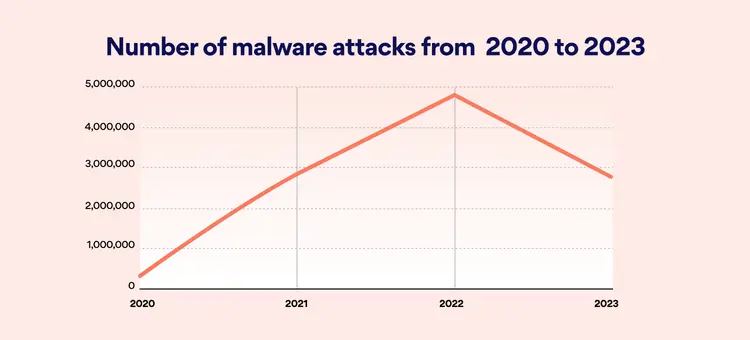Which countries are most targeted by malware attacks?

Over 11 million malware attacks have been recorded across the world in the last four years in the wake of cybercriminals utilising "increasingly sophisticated hacking techniques," according to a new report.
The analysis from NordPass on cybersecurity incident data from January 2020 to September 2023 revealed a "terrifying" upward trend in reported cases of malware attacks.
NordPass found approximately 614,144 malware-related incidents reported across the world in 2020. This soared by more than four times in 2021 after reaching 2,898,142, then nearly doubled again to 4,858,963 in 2022.
In the first nine months of 2023, there were also 2,678,841 malware attacks reported, with NordPass noting that the number of cases would likely be higher if the whole year was recorded.

Source: NordPass
According to NordPass, the most prevalent type of malware in the last four years was RedLine, which accounted for 59% of the overall attacks recorded during the period. Coming after it is Vidar (18%) and then Raccoon (12%).
"We noticed that cybercriminals are using increasingly sophisticated hacking techniques and targeting their attacks more precisely, including towards governmental institutions and critical infrastructure," said Tomas Smalakys, chief technology officer (CTO) of NordPass, in a statement.
Most targeted nations for malware attacks
Smalakys said threat actors behind malware attacks usually seek monetary gain, using their access to sensitive data to leverage a ransom payment or sell data.
"Malware steals data from places you may not imagine, including Excel sheets, browsers, and text documents where many save their passwords and other important credentials," the CTO said.
By location, the country with most users experiencing malware attacks in the last four years is Brazil, with over 9.6 million users targeted. The whole list include:
- Brazil - 9,659,846 affected users
- USA - 6,966,426 affected users
- India - 6,914,742 affected users
- Indonesia - 5,354,246 affected users
- Vietnam - 3,611,798 affected users
- Egypt - 3,516,376 affected users
- Mexico - 3,042,467 affected users
- The Philippines - 2,926,483 affected users
- Turkey - 2,888,663 affected users
- Pakistan - 2,849,788 affected users
"Internet users are still not aware of the consequences these attacks may have on their lives," Smalakys said. "Granting hackers access to, let's say, your Google account, could initially block you from your digital life, given many of us use Google to join other platforms too."
Most targeted domains
According to NordPass, most targeted domains of malware attacks are cloud servers, email accounts, and social media platforms. They include:
- accounts.google.com - 8.2 million stolen records
- facebook.com - 5.9 million stolen records
- login.live.com - 5.6 million stolen records
- m.facebook.com - 3.2 million stolen records
- Instagram.com - 3.1 million stolen records
- discord.com - 3.1 million stolen records
- netflix.com - 3 million stolen records
- roblox.com - 2.8 million stolen records
- com.facebook.katana - 2.5 million stolen records
- amazon.com - 2.4 million stolen records
- paypal.com - 2.3 million stolen records
- twitter.com - 2.3 million stolen records
Protection from malware
The findings come amid warnings that organisations are too overconfident in their cybersecurity despite being less than ready to face them.
The biggest concern is still employees, as human error remained the leading cause of data breaches in 2023.
To avoid being victimised by malware attacks, Smalakys offered four measures that individuals can take:
Be careful with email activity: Avoid clicking on harmful links or downloading potentially infected attachments.
Use antivirus software to detect and remove malware from devices: A good antivirus software scans the system constantly for known malware signatures.
Keep operating systems, applications, and firmware up to date: Cybercriminals often target known security vulnerabilities, so updating the system is crucial in maintaining security.
Use a password manager: Such tools allow users to generate unique and complex passwords, as well as reduce chances of unauthorised access.








